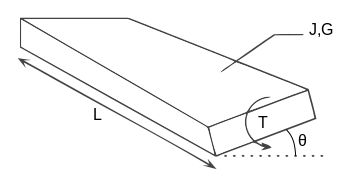Torsion constant: Difference between revisions
| Line 3: | Line 3: | ||
== History == |
== History == |
||
In 1820, the French engineer A. Duleau derived analytically that the torsion constant of a beam is identical to the [[second moment of area]] normal to the section J<sub>zz</sub>, which has an exact analytic equation, by assuming that a plane section before twisting remains plane after twisting, and a diameter remains a straight line. |
In 1820, the French engineer A. Duleau derived analytically that the torsion constant of a beam is identical to the [[second moment of area]] normal to the section J<sub>zz</sub>, which has an exact analytic equation, by assuming that a plane section before twisting remains plane after twisting, and a diameter remains a straight line. |
||
Unfortunately, that assumption is correct only in beams with circular cross-sections, and is incorrect for any other shape.<ref> |
Unfortunately, that assumption is correct only in beams with circular cross-sections, and is incorrect for any other shape where warping takes place.<ref> |
||
Archie Higdon et al. |
Archie Higdon et al. |
||
"Mechanics of Materials, 4th edition". |
"Mechanics of Materials, 4th edition". |
||
Revision as of 23:40, 30 August 2014
The torsion constant is a geometrical property of a bar's cross-section which is involved in the relationship between angle of twist and applied torque along the axis of the bar, for a homogeneous linear-elastic bar. The torsion constant, together with material properties and length, describes a bar's torsional stiffness. The SI unit for torsion constant is m4.
History
In 1820, the French engineer A. Duleau derived analytically that the torsion constant of a beam is identical to the second moment of area normal to the section Jzz, which has an exact analytic equation, by assuming that a plane section before twisting remains plane after twisting, and a diameter remains a straight line. Unfortunately, that assumption is correct only in beams with circular cross-sections, and is incorrect for any other shape where warping takes place.[1]
For non-circular cross-sections, there are no exact analytical equations for finding the torsion constant. However approximate solutions have been found for many shapes. Non-circular cross-section always have warping deformations that require numerical methods to allow the exact calculation of the torsion constant.[2]
Partial Derivation
For a beam of uniform cross-section along its length:
where
- is the angle of twist in radians
- T is the applied torque
- L is the beam length
- J is the moment of inertia
- G is the Modulus of rigidity (shear modulus) of the material
Examples for specific uniform cross-sectional shapes
Circle
where
- r is the radius
This is identical to the second moment of area Jzz and is exact.
alternatively write: [3] where
- D is the Diameter
Ellipse
where
- a is the major radius
- b is the minor radius
Square
where
- a is half the side length
Rectangle
where
- a is the length of the long side
- b is the length of the short side
- is found from the following table:
| a/b | |
|---|---|
| 1.0 | 0.141 |
| 1.5 | 0.196 |
| 2.0 | 0.229 |
| 2.5 | 0.249 |
| 3.0 | 0.263 |
| 4.0 | 0.281 |
| 5.0 | 0.291 |
| 6.0 | 0.299 |
| 10.0 | 0.312 |
| 0.333 |
Alternatively the following equation can be used with an error of not greater than 4%:
Thin walled closed tube of uniform thickness
- [8]
- A is the mean of the areas enclosed by the inner and outer boundaries
- t is the wall thickness
- U is the length of the median boundary
Thin walled open tube of uniform thickness
- [9]
- t is the wall thickness
- U is the length of the median boundary (perimeter of median cross section)
Circular thin walled open tube of uniform thickness (approximation)
This is a tube with a slit cut longitudinally through its wall.
- [8]
- t is the wall thickness
- r is the mean radius
This is derived from the above equation for an arbitrary thin walled open tube of uniform thickness.
Commercial Products
There are a number specialized software tools to calculate the torsion constant using the finite element method.
- ShapeDesigner by Mechatools Technologies
- ShapeBuilder by IES Web
- STAAD SectionWizard by Bentley
- SectionAnalyzer by Fornamagic Ltd
- Strand7 BXS Generator by Strand7 Pty Limited
References
- ^ Archie Higdon et al. "Mechanics of Materials, 4th edition".
- ^ Advanced structural mechanics, 2nd Edition, David Johnson
- ^ a b "Area Moment of Inertia." From MathWorld--A Wolfram Web Resource. http://mathworld.wolfram.com/AreaMomentofInertia.html
- ^ a b Roark's Formulas for stress & Strain, 7th Edition, Warren C. Young & Richard G. Budynas
- ^ Continuum Mechanics, Fridtjov Irjens, Springer 2008, p238, ISBN 978-3-540-74297-5
- ^ Torsion Equations, Roy Beardmore, http://www.roymech.co.uk/Useful_Tables/Torsion/Torsion.html
- ^ Advanced Strength and Applied Elasticity, Ugural & Fenster, Elsevier, ISBN 0-444-00160-3
- ^ a b Roark's Formulas for stress & Strain, 6th Edition, Warren C. Young
- ^ Advanced Mechanics of Materials, Boresi, John Wiley & Sons, ISBN 0-471-55157-0














